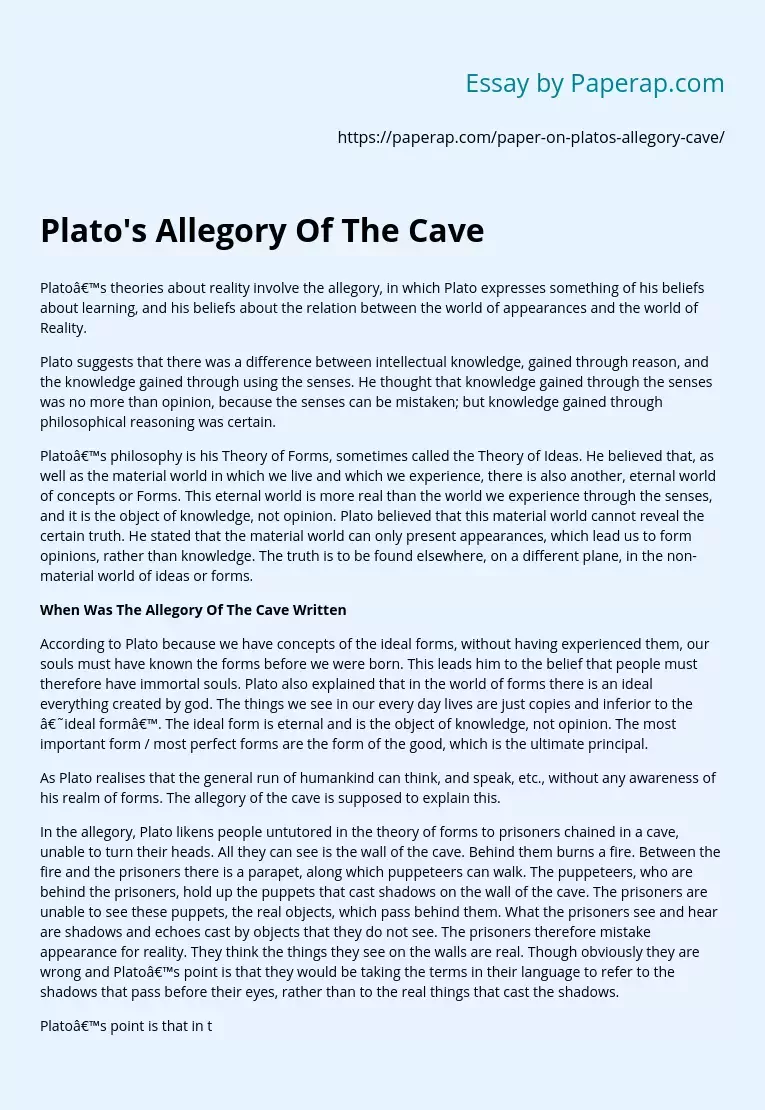Plato's Allegory Of The Cave
Plato’s theories about reality involve the allegory, in which Plato expresses something of his beliefs about learning, and his beliefs about the relation between the world of appearances and the world of Reality.
Plato suggests that there was a difference between intellectual knowledge, gained through reason, and the knowledge gained through using the senses. He thought that knowledge gained through the senses was no more than opinion, because the senses can be mistaken; but knowledge gained through philosophical reasoning was certain.
Plato’s philosophy is his Theory of Forms, sometimes called the Theory of Ideas. He believed that, as well as the material world in which we live and which we experience, there is also another, eternal world of concepts or Forms. This eternal world is more real than the world we experience through the senses, and it is the object of knowledge, not opinion. Plato believed that this material world cannot reveal the certain truth. He stated that the material world can only present appearances, which lead us to form opinions, rather than knowledge.
The truth is to be found elsewhere, on a different plane, in the non-material world of ideas or forms.
When Was The Allegory Of The Cave Written
According to Plato because we have concepts of the ideal forms, without having experienced them, our souls must have known the forms before we were born. This leads him to the belief that people must therefore have immortal souls. Plato also explained that in the world of forms there is an ideal everything created by god.
The things we see in our every day lives are just copies and inferior to the ‘ideal form’. The ideal form is eternal and is the object of knowledge, not opinion. The most important form / most perfect forms are the form of the good, which is the ultimate principal.
As Plato realises that the general run of humankind can think, and speak, etc., without any awareness of his realm of forms. The allegory of the cave is supposed to explain this.
In the allegory, Plato likens people untutored in the theory of forms to prisoners chained in a cave, unable to turn their heads. All they can see is the wall of the cave. Behind them burns a fire. Between the fire and the prisoners there is a parapet, along which puppeteers can walk. The puppeteers, who are behind the prisoners, hold up the puppets that cast shadows on the wall of the cave. The prisoners are unable to see these puppets, the real objects, which pass behind them. What the prisoners see and hear are shadows and echoes cast by objects that they do not see. The prisoners therefore mistake appearance for reality. They think the things they see on the walls are real. Though obviously they are wrong and Plato’s point is that they would be taking the terms in their language to refer to the shadows that pass before their eyes, rather than to the real things that cast the shadows.
Plato’s point is that in terms of our language are not ‘names’ of the physical objects that we can see. They are actually names of things that we cannot see, things that we can only grasp with the mind. This statement refers back to Plato’s theory upon what we presume is reality is in fact mere the opposite.
When the prisoners are released, they can turn their heads and see the real objects. Then they realise the error. Plato’s aim is to describe what is necessary for us to achieve this reflective understanding. But even without it, it remains true that our very ability to think and to speak depends on the forms. The prisoners may learn what certain objects are as they would have seen the shadows of them but if they referred back to a certain object thinking of the shadows they would be mistaken.
Likewise, we may acquire concepts by our perceptual experience of physical objects. But we would be mistaken if we thought that the concepts that we grasp were on the same level as the things we perceive. Also referring back to the perfect form, the form of good in the story ‘the cave’ is the sun as the good illuminates the other forms.
The allegory of the cave overall, suggests that people are ‘philosophically ignorant’, and are like the prisoners chained to the floor of the cave. They can only see the shadows playing on the back of the cave. They assume that these shadows are in fact the whole of reality.
The world outside represents the world of the forms. The prisoner who escapes is like the person who achieves ‘philosophical enlightenment.’
Plato’s, forms are sorts, kinds or types of things. They were not created, and they do not do anything. They are simply ‘there’. The forms are timeless, unchanging and beyond space. The created world, by contrast, is made of contingent, imperfect, ‘stuff’, which has been subjected to change and also decay.
Plato's Allegory Of The Cave. (2019, Dec 05). Retrieved from https://paperap.com/paper-on-platos-allegory-cave/

